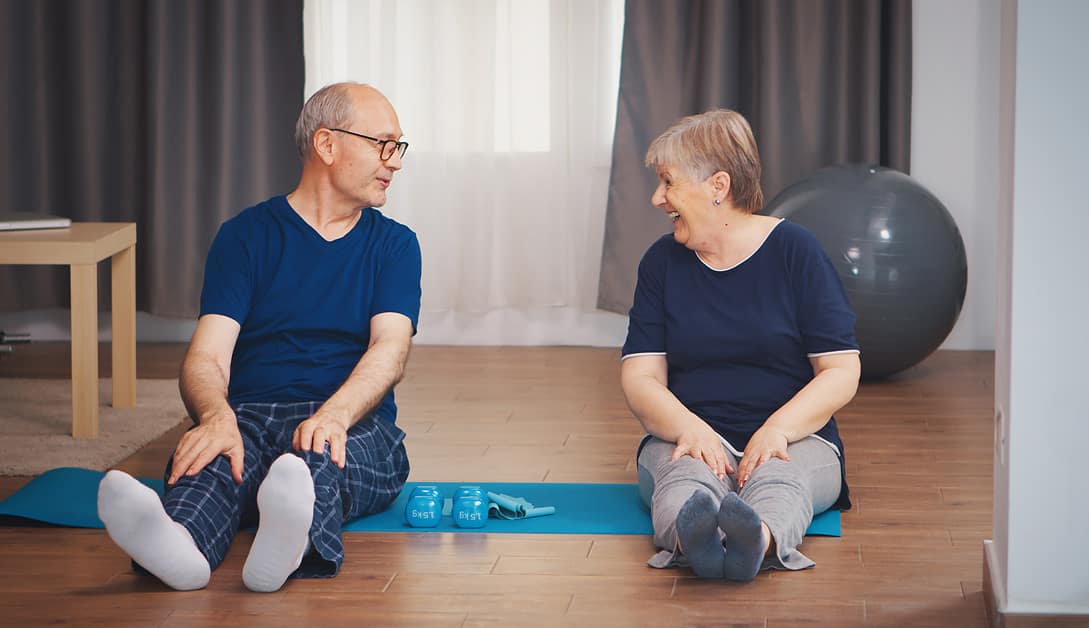Introduction
Millions of folks across the globe struggle with knee osteoarthritis. It can severely limit mobility and be quite debilitating. Exercise and stretching are important parts of treatment and management.
Dynamic stretching is a feasible and safe option to ease pain and increase motion range. Let’s dive into dynamic stretching and knee osteoarthritis in this article.
Definition of Osteoarthritis
Osteoarthritis (OA) is an issue with your joints. It is caused by the wear-and-tear on them, and it leads to cartilage degradation, changes in the subchondral bone, synovial membrane, and intra-articular structures. OA is a degenerative disorder with inflammation, pain, and reduced mobility. It usually affects older people, but can appear at any age. Signs of OA may be joint swelling, stiffness, and pain when moving or bearing weight on the joint.
To manage OA, there are different ways:
- Medication
- Injections
- Physical therapy
- Device support like braces
- Dynamic stretching which uses controlled movements with incremental improvements in range to create fluidity without hurting yourself. It has been found to be a safe way for long term OA treatment.
Symptoms of Osteoarthritis
Osteoarthritis (OA) of the knee is a disabling condition that is very common. It brings pain, stiffness, swelling, and difficulty walking. 10-15% of adults over 45 suffer from it in the US, with 25 million having it in their knees.
You may notice:
- Pain when standing or bearing weight
- Creaking or grinding noises
- Stiffness
- Loss of flexibility
- Inflammation
- Warmth
- Tenderness
- Deformity of the knee
- Swelling or fluid build-up
The most common locations are around the kneecap, as well as between the leg bones. OA can also cause pain and restricted movement in other areas such as ankles, feet, and hips.
Benefits of Dynamic Stretching
Do you want to know the many advantages of dynamic stretching? It can increase muscle strength and flexibility, as well as reduce pain from knee osteoarthritis. Plus, it’s safe! Read on for all the details about how dynamic stretching can improve your quality of life.
It uses movement to increase muscle flexibility and range of motion. Joint mobility is improved, too. Give it a try!
Improved range of motion
Dynamic Stretching is an active form of stretching. It progresses the intensity and extent of the stretch. The goal is to move joint, muscle, and tissue within a comfortable range. No straining needed!
Dynamic stretching for knee osteoarthritis can reduce pain and discomfort. It builds strength and increases flexibility too. This helps restore movement in stiff or painful areas. It also increases circulation throughout the body.
Through proper breathing and consistent practice, dynamic stretching can strengthen weak muscles and joints around the knee. This gives you stability for daily activities. If you have mild knee osteoarthritis or limited mobility, dynamic stretching is especially beneficial.
Reduced pain and stiffness
Dynamic stretching can reduce pain and stiffness due to knee osteoarthritis. It also increases flexibility in and around the knee joint. Studies show that dynamic exercises, like high knees, reverse lunges and side leg lifts, help improve physical function and decrease discomfort.
Dynamic stretching warms up muscles, making them looser. This allows for more motion and decreases strain on the arthritic joint. Range of motion and the muscles around the joint get stronger, which improves stability and reduces stress on other parts of the body. So dynamic stretching is an excellent form of rehabilitation that promotes positive results in people with knee osteoarthritis.
Improved balance and coordination
Dynamic stretching boosts control and balance by activating muscles through gentle motion. It warms up the body, increases flexibility and coordination. Dynamic stretches include: increased range of motion with muscle contractions, smooth transitions between activity levels and postural corrections to increase body awareness.
Improved range of motion allows efficient movements, reducing injury risk. It even decreases joint pain and can be used as maintenance on days off training.
Examples of dynamic stretches:
- High leg extensions while skipping.
- Leg swings forward/backward and side-to-side.
- Arm circles.
- Shoulder rolls.
- Arm swings.
Dynamic Stretching for Knee Osteoarthritis
Dynamic Stretching for Knee Osteoarthritis is becoming very popular. It’s an exercise that helps individuals with this condition. Dynamic stretching is different from other types of stretching. It focuses on increasing muscle length and flexibility with movement. The aim is to improve mobility and reduce pain. It also helps support joint health and stability.
Let’s look at how dynamic stretching can help people with knee osteoarthritis:
Quadriceps stretch
Do the quadriceps stretch to help improve knee range of motion and flexibility. It also strengthens the hip muscles. This is an important exercise for those living with knee osteoarthritis, as it builds strength and stability in the joint.
To do:
- Stand, lifting one foot and holding onto a wall or stable object for balance.
- Hold your ankle, pulling your foot towards your buttock until you feel a stretch in your thigh.
- Hold the position for 20-30 seconds and switch sides.
- Repeat 2-3 times per leg while standing tall with good posture.
- Be aware that any discomfort should be minimal and comfortable. If pain persists, stop stretching and consult a healthcare professional for better hip flexor stretches.
Hamstring stretch
The hamstring stretch is an exercise to help with knee osteoarthritis. You don’t need much equipment, it can be done from home. It helps with flexibility in the back of the thigh. It also supports the knee joint and protects it from injury.
To do it, stand up straight. Place one foot on a flat surface like a stair or step. Hold onto something for balance, like a wall or railing. Bend the back knee slightly, stay tall (don’t lean forward). When it’s comfortable, hold it for 15-30 seconds then stand again. Switch legs and do it on the other side. Repeat 5-10 times per leg, according to individual tolerance levels.
Calf stretch
Calf stretches can be helpful for those with knee osteoarthritis. For this exercise, move slowly and take your time. Stand behind a stable chair or table for balance. Extend one leg backward, and press the heel towards the ground. Stretch the calf muscles and keep your back straight and feet flat. Bring the flexed knee to the chest, if desired. Hold the position for 15-30 seconds and repeat on each leg.
Dynamic stretching through calf stretches may reduce pain and improve flexibility, relaxation and joint range of motion. Doing it regularly can help maintain an active lifestyle with knee arthritis.
Gluteal stretch
Gluteal stretch is a dynamic exercise to help knee osteoarthritis. It focuses on the muscles that control the hip motion.
- Stand in a comfortable position with feet shoulder-width apart.
- Bring up the left knee to the chest. Bend the right leg and keep the toes on the ground. Hold for a few seconds, then slowly return to the starting position. Do this 5-10 times, and switch legs. Don’t overextend, only move within a comfortable range of motion. Keep your back straight throughout the exercise.
Dynamic stretching of gluteal muscles can improve flexibility, stability and strength around the hip joint. This can help relieve symptoms from knee osteoarthritis. It also helps with lower extremity movements during sports and everyday activities. Such improvements also ensure better postural alignment for other non-weight bearing joints, such as elbows and wrists.
Safety Considerations
Safety is key when exercising with knee osteoarthritis. Dynamic stretching is a great way to boost range of motion, reduce pain, and gain strength. But before starting, it’s best to follow safety guidelines. This can lower the risk of injury and get the best results.
Follow these safety guidelines for dynamic stretching:
- Warm up the muscles before stretching.
- Start with smaller movements and increase the range of motion as you become more comfortable.
- Breathe steadily and deeply during stretching.
- Hold each stretch for 10-30 seconds.
- Listen to your body and stop if you feel any pain.
Warm up before stretching
It’s important to warm up muscles before stretching. This prepares them for activity and helps prevent injury. Warm-up activities could be jogging, walking or cycling. The focus is on gradually increasing your heart rate.
Do dynamic stretching exercises like leg swings, arm circles, hip twists and trunk rotations. Start slowly. This prevents muscle strains and pulls. Begin slowly as it helps you become more comfortable with new movements.
After warming up, do dynamic stretches that move beyond your normal range of motion, but don’t force the body into an uncomfortable position.
Avoid stretching to the point of pain
Dynamic stretching should never cause pain. So, keep the intensity and duration of stretches low. Also, limit the type of dynamic movements. Hold each stretch for a few seconds. Focus on proper form and minimize any pain. Stop stretching if pain persists or worsens. If adverse effects occur, consult a healthcare professional.
Listen to your body. If a stretch causes more pain, move on to another. Some stretches worsen symptoms if they involve movements targeting areas affected by knee OA, like deep squats or lateral lunges. Begin slowly and gradually increase intensity over time. Know what works best for your individual needs and abilities.
Conclusion
This review suggests dynamic stretching is a secure and successful way to improve knee osteoarthritis symptoms. It looks like dynamic stretching can better physical function, such as increasing flexibility, strength, range of motion and balance. Plus, it could minimize pain levels and raise quality of life.
Investigating the long-term effects of dynamic stretching on knee osteoarthritis symptoms, as well as different combinations of stretching techniques, should be looked at in future studies. Also, specific programs for people with knee osteoarthritis should be made.
Frequently Asked Questions
Q1: What is dynamic stretching?
A1: Dynamic stretching is a form of stretching that involves movement and momentum in order to increase the range of motion in a joint. It is an effective way to increase flexibility and strength in the muscles and joints, and is often used as part of a warm-up routine before physical activity.
Q2: Is dynamic stretching safe for those with knee osteoarthritis?
A2: Yes, dynamic stretching can be a safe and effective option for those with knee osteoarthritis. Dynamic stretching can help to improve flexibility, strength and range of motion in the affected joint, reducing pain and stiffness. It is important to consult a physical therapist or doctor before starting any type of stretching routine.
Q3: What are some exercises that can be done as part of a dynamic stretching routine?
A3: Some examples of dynamic stretching exercises include walking and high knee lifts, leg swings, and lateral lunges. It is important to start with low intensity exercises and to gradually increase intensity as the body gets used to the stretching routine.





